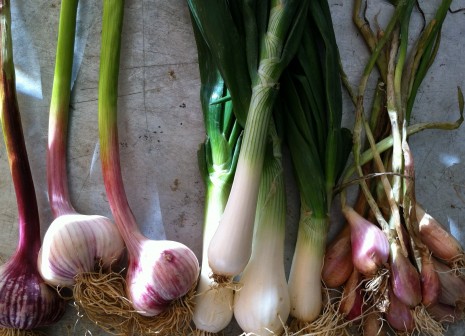SPRING’S GARLIC, ONIONS, & SHALLOTS
Every season has its stars. This time of year, people queue at farmers markets for ramps, one of the most pungent members of the vast Allium genus. I’m far more interested, however, in the heaps of fresh garlic, onions, and shallots I see, and on my last few visits to the Greenmarket, I slope off with an armload. The juiciness and sweet-sharp flavors of these more nuanced alliums ground everything I cook completely in the moment.
That’s because they are young bulbs that have just been pulled out of the soil, unlike the mature garlic, onions, and shallots we all rely on for much of the year. After harvest, those are cured—that is, allowed to dry so their stalks wither and the skins tighten around the bulbs. The thick, tight outer layer that results from curing protects the produce during winter storage.
At its earliest stage, green, or spring, garlic can resemble a scallion or baby leek, and once you peel off its tough outer sheath, you can use it the white and pale-green parts in the same way. The green garlic you see at left in the photo above is more mature. Its leaves and stalk have become more fibrous, and it has also formed cloves; you’ll want to remove the thickened, moist skin around them before using. Its flavor is mild yet more rounded than its very early green counterpart, and the succulent bulbs lends themselves to—well, just about everything I cook these days, from salad dressings to sautéed spinach. I’m not alone: Martha Rose Shulman has made me crave a frittata, and David Tanis got me thinking about what gently warmed young garlic can do for potatoes and more. Yesterday, Memorial Day, I put a lavish amount of it in a chimichurri sauce for flank steak. Instead of overwhelming the cilantro and parsley, it somehow enriched the herbs instead. The end result was lush and verdant—the best I’ve ever made.
Green, or spring, onions (above, center) are young common onions, and the size of the bulbs depends on how long the plants remain in the ground. And what’s the diff between spring/green onions and scallions? A scallion, a long, slim type of onion, will never develop a bulb, no matter how mature it becomes.
Spring onions are quick cooking and thus a building block for many sautés. They’re lovely when sliced thin and cooked with asparagus or blanched fresh fava beans; spoon the resulting tenderness over pasta and shower with shavings of Pecorino Romano. They are also reason alone for a celebration. You could channel James Beard and prepare his herbed onion tea sandwiches for a drinks party. Or, if you are in the mood for a grander gesture, there is always a Catalan-style calçotada—or simply your backyard grill and plenty of romesco sauce.
Like garlic, the onion is among our most ancient crops, in all likelihood first cultivated in the mountains of Central Asia. The shallot (above, right) isn’t a separate allium species, but a variety of onion that freely multiplies, forming clusters of several lateral bulbs. Even when young, shallots have a more complex sweetness than common onions do; their flavor is subtle and intense all at the same time. If you tend to avoid shallots because they’re fiddly to peel, then now is the time to use them with abandon; the skin on the spring bulbs is relatively loose.
Lately, my vinaigrette of choice has been one with finely diced spring shallots, Champagne vinegar, a spritz of fresh lemon juice, and mild Alziari olive oil. Thinly sliced shallots, barely cooked with butter and a drizzle of balsamic vinegar, make a satisfying topping for a steak or burger. Quickly frizzled in olive oil and butter, they’re wonderful stirred into a warm potato salad made aromatic with thyme or tarragon.
Spring garlic, onions, and shallots are perishable, so refrigerate them like you would fresh green produce. Wrapped in a slightly damp kitchen towel and tucked in the vegetable crisper, my bulbs keep for at least a week. If you need to use them up (why? to make room for more, silly), cook them all together in one big glorious tangle and use them as a topping for a pizza. Some mozzarella and a veil of thinly sliced prosciutto di Parma will bring it home.
Posted: May 29th, 2012 under cooking, spring, Union Square Greenmarket.


